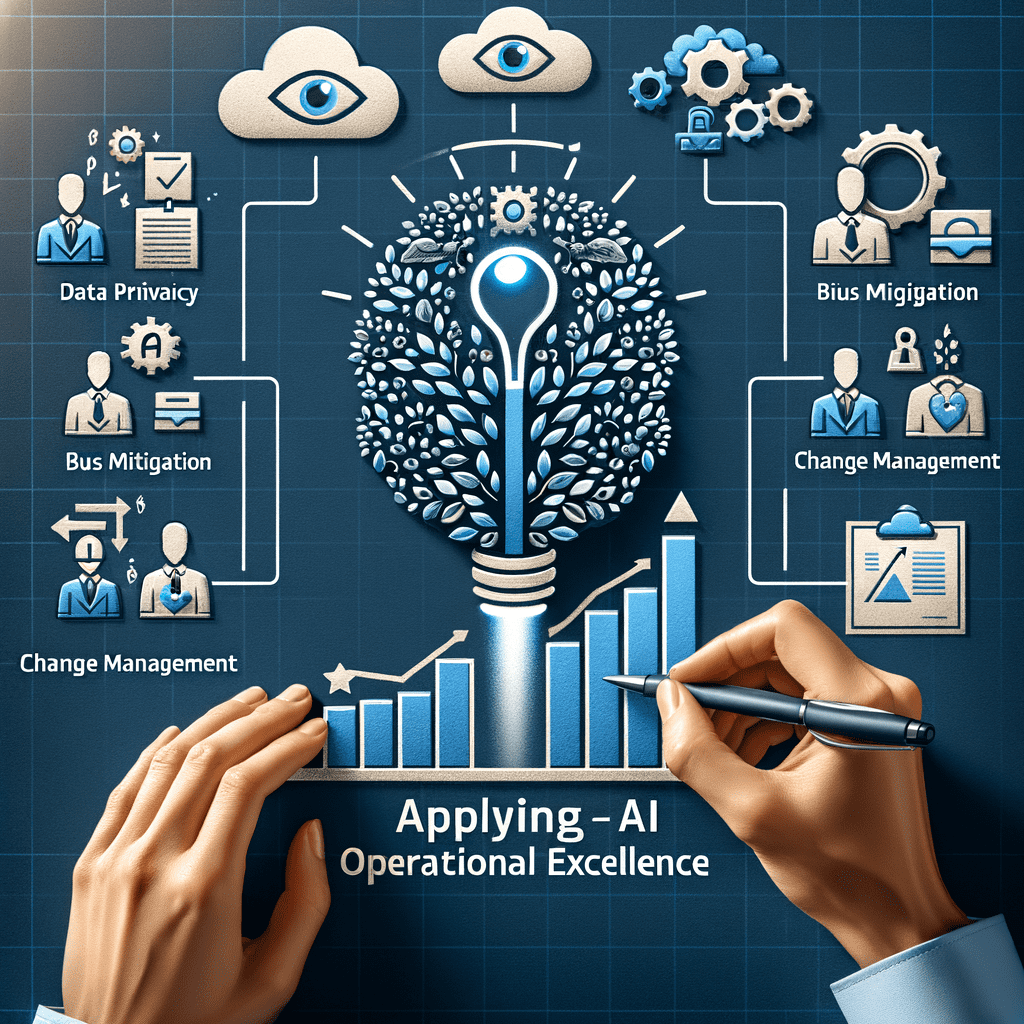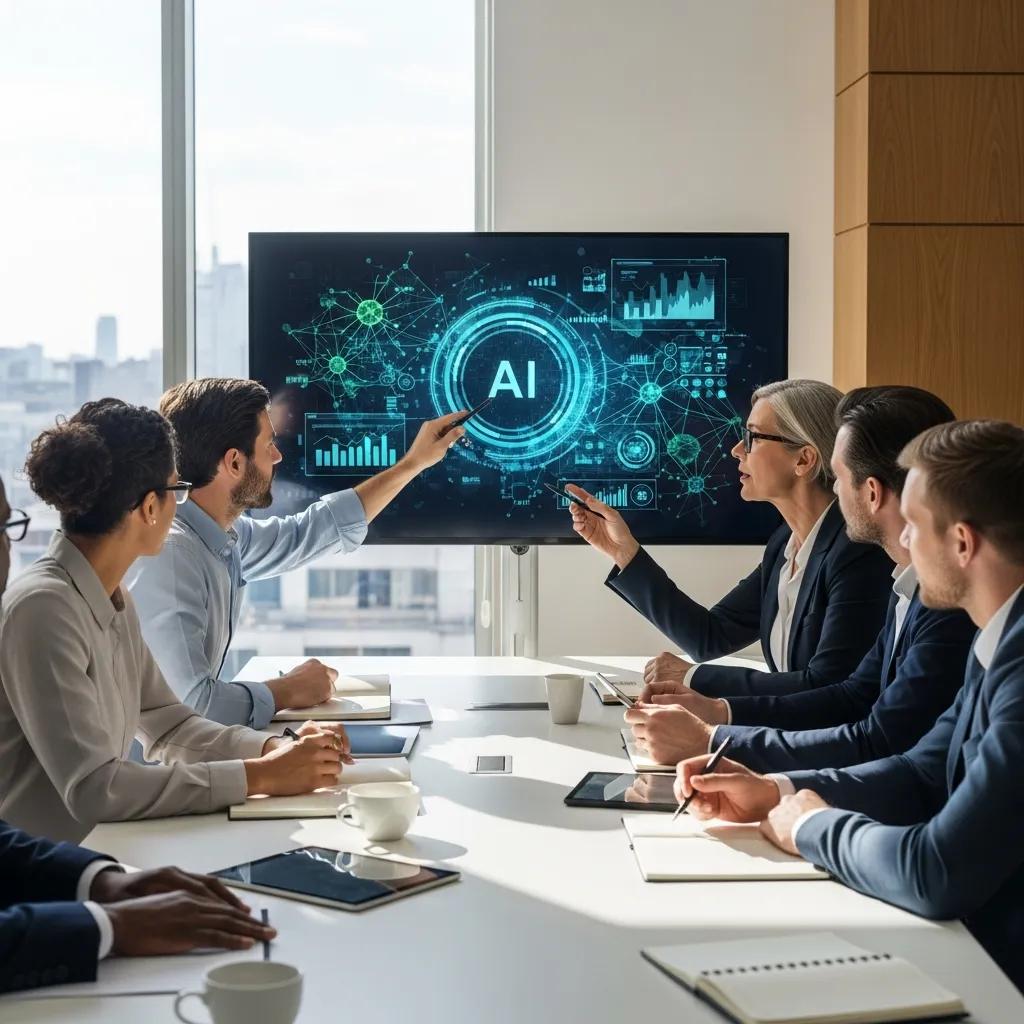Businesses today are looking for an edge – something to give them an advantage in a competitive market. The truth is, for companies looking to gain efficiency and agility, a new strategy might be needed. Enter the intersection of cutting-edge technology and a powerful business philosophy – AI for Operational Excellence. With the rise of AI solutions and advanced data analysis, companies have an opportunity to revolutionize how they operate and achieve long-lasting success. What if, instead of dreading another tedious report, you could have AI handle it while you focused on big-picture strategies? Picture this, instead of scrambling to fix an unexpected machine failure, your AI system warns you ahead of time, allowing for smooth, scheduled maintenance. This isn’t just the plot of a sci-fi movie; this is the reality that AI for Operational Excellence can offer.
The Fusion of AI and Operational Excellence: A Powerful Partnership
Let’s start by breaking things down. AI for operational efficiency refers to using artificial intelligence to boost a company’s effectiveness, productivity, and overall performance. AI’s impact can be seen across several aspects of a business. Take Audi, for instance. At an Audi plant in Germany, AI analyzes spot welds – those critical points where sheets of metal join together. This frees employees from time-consuming manual inspection.
By implementing advanced AI systems for quality control, Audi not only enhances the precision of their manufacturing process, but also significantly reduces the risk of defects. This integration of technology allows for more efficient workflows and innovative problem-solving approaches, ultimately leading to cost savings. Furthermore, boosting AI performance strategies plays a crucial role in these advancements, enabling the company to maintain high standards while scaling production effectively.
So what is Operational Excellence? It’s about getting the most out of every process, every team member, and every resource within a company. It’s the driving force behind minimizing waste, increasing efficiency, and continuously searching for improvement. It might seem like something that only benefits manufacturing businesses. However, the core principles – such as Lean, Six Sigma, and continuous improvement, actually benefit businesses of any type and size.
For instance, you could use Lean methodologies to map out and analyze the flow of paperwork within your office. By identifying any bottlenecks or areas of waste, your team could work to simplify and streamline processes, saving both time and resources. When we bring AI and Operational Excellence together, it becomes clear they complement each other. The beauty of AI lies in its ability to automate tasks traditionally done by humans, provide actionable insights through advanced analytics, boost productivity, and enable predictive maintenance.
- Automate Mundane Tasks : AI is able to handle repetitive tasks such as data entry, scheduling, and report generation, freeing up employees for tasks that call for creativity and problem-solving. You could imagine having an AI system set up to automate your social media posts. Instead of spending time each day creating content, the AI pulls from your blog posts and other relevant resources to consistently post relevant information across your various channels.
- Provide Actionable Insights : Analyzing data can be incredibly helpful for discovering hidden trends and patterns. AI, especially those powered by machine learning and Natural Language Processing, digs deeper into vast datasets. These deep insights allow teams to make more informed decisions. Imagine analyzing customer interactions with your customer service team. AI algorithms might find that there are several reoccurring questions that your customers consistently need help with. With this information, your team could create detailed self-service guides so that customers could more easily find the answer for themselves, improving the overall customer service experience while reducing the burden on your support staff.
- Boost Productivity : Imagine an AI-powered tool that can accurately generate expense reports. It pulls from a digital bank account and creates accurate reports quickly – this means no more struggling with receipts or worrying about data entry errors. By optimizing resource allocation, streamlining operations, and preventing issues, productivity reaches new heights.
- Predictive maintenance : Businesses using predictive maintenance gain a powerful advantage as AI-powered systems can accurately predict when equipment will fail, scheduling necessary maintenance and minimizing unplanned downtime. The impact on cost savings, reduced downtime, and equipment life span is huge.
Transforming Business Operations with AI: Practical Applications
So how does this partnership actually work in the real world? The most impactful use cases for AI for Operational Excellence can be found in just about every department of a modern business. Here are some real-life examples of companies currently employing AI:
Let’s go back to Zara , a household name in fast fashion, and examine how they use AI within their operations. Zara smartly uses microchips embedded in their garments and packaging. With RFID tags working seamlessly with their data analytics system, they’ve got an efficient way to handle their inventory. By combining advanced technologies, they ensure popular clothing is ready and available to meet customer demand.
Logistics company Maersk has a cash collections team. It used to take them considerable time and effort to manually track payment status and follow up on past-due invoices. Maersk then implemented intelligent automation and was able to more easily manage its cash flow and assess risk. Their process has become less dependent on human resources. It was then able to use its past history with customers and payment patterns to proactively create a smoother collections system. By taking advantage of customer insights, their teams could anticipate customer behavior and manage cash flow more efficiently, giving their team members a greater chance of success.
Sales Forecasting
Sales are the lifeblood of many businesses, and having accurate sales forecasting is vital to ensuring growth. Using traditional methods can be unreliable as sales forecasting usually involves manually collecting data. They might involve spreadsheets and are often dependent on intuition and guesswork. With the implementation of AI powered by Machine Learning and AI , businesses have access to more data than ever before. Using this data, teams can create more precise models which are able to account for both external and internal factors.
HR and AI
Gone are the days of sifting through mountains of resumes. The tedious task of identifying promising candidates from the pool of applicants can be a monumental task, even with several employees working diligently. AI enables machines to streamline this process, making it easier for businesses to improve their hiring process and employee experiences. It’s really quite amazing. By leveraging AI in Human Resources, HR teams can:
- Automate resume screening by quickly and accurately identifying the most qualified candidates. They do this by analyzing skills and experience from candidates and comparing them against the job description.
- Facilitate a smooth onboarding experience, reducing administrative tasks while providing comprehensive guidance to newly hired staff. AnAI chatbot , for example, could easily answer common questions about benefits and provide necessary paperwork for new hires without requiring the time and involvement of the human resource team.
- Create a system of continuous feedback and learning, promoting ongoing employee development while helping identify any potential dissatisfaction and taking proactive measures.
- Optimizing Resource Allocation: The true strength of AI goes beyond automating routine tasks. Machine Learning plays a pivotal role in strategically distributing resources to ensure smooth and streamlined operations. For instance, AI-powered workforce management solutions have revolutionized how businesses approach resource allocations . By utilizing accurate forecasts of customer traffic or order volumes, these platforms automatically generate staffing schedules that are aligned with the needs of the business, taking into account historical data.
As organizations increasingly turn to AI for Operational Excellence and streamline operations, the potential for substantial growth becomes significant. According to Grand View Research , the artificial intelligence market was valued at a whopping 196.63 Billion USD in 2023. They project that the compound annual growth rate between 2024 and 2030 will be 36.6%. And yet, reports indicate that while 72% of global companies have begun incorporating AI into their operations, most are still experimenting. But make no mistake; this technology is not a fad – it’s the new standard. If you are thinking about how you can get ahead in business, integrating AI may be the best way.
Investing in AI integration consulting services can provide organizations with the expertise needed to tailor AI applications that align with their unique operational goals. These services can help businesses navigate the complexities of implementation, ensuring a smoother transition and maximizing return on investment. By leveraging AI effectively, companies can not only improve efficiency but also gain a competitive edge in their respective markets.
Furthermore, organizations must develop comprehensive ai strategies for business success that encompass the right tools, training, and cultural shifts necessary for effective AI adoption. By fostering a data-driven decision-making environment and empowering employees through education and resources, companies can create a sustainable framework for leveraging AI. Ultimately, those that prioritize these strategies will not only adapt to the changing landscape but thrive in it.
To further enhance their AI initiatives, organizations should consider partnering with established experts in the field. A top AI consulting firms overview can provide valuable insights into the latest technologies and methodologies that drive success. By leveraging these partnerships, businesses can ensure they are making informed decisions that align with industry best practices, ultimately accelerating their AI integration and maximizing their operational potential.
Additionally, engaging with a top AI consulting firms overview can help organizations benchmark their progress against competitors, identifying areas for improvement and innovation. These firms can also assist in creating tailored KPIs to measure the effectiveness of AI implementations, ensuring that investments yield significant returns. Ultimately, a strategic collaboration with AI experts can streamline the integration process, paving the way for a more adaptive and resilient business model in an ever-evolving market landscape.
Addressing Challenges and Embracing Opportunities
It’s very important that we keep data privacy at the top of our priority list when implementing AI solutions. While there are significant benefits to be had, businesses are obligated to handle personal data with care, integrity, and consideration for their customers, clients, and team members. For starters, you will want to familiarize yourself with regulations such as the CCPA in the United States as well as the GDPR in the EU. These outline specific responsibilities when handling information that is deemed personal or sensitive.
If your business utilizes AI in any way that collects personal or sensitive information, the responsibility lies with you to ensure your team is fully prepared and has all necessary compliance plans in place. In short, make sure you are using robust security measures. The last thing you want to do is expose any sensitive information.
It’s also very important to know that your company might face several challenges while integrating AI solutions within your operations. Implementing a change management process is critical for successfully onboarding any new systems. It becomes even more critical with AI. Because AI solutions have the power to fundamentally change how your business operates, you should provide proper training and give clear information and communication about the new systems so your team feels comfortable with the new tools they will be working with.
It’s likely that your employees might have questions and even feel fearful of losing their jobs because of these AI systems. If you involve the workforce in the decision-making and planning process, you give them ownership, making them a valuable resource while fostering collaboration and a willingness to accept these changes. When properly implemented, AI solutions improve operational efficiency . They free up team members to take on different tasks, leading to new challenges and increased job satisfaction.
To make the best use of AI, companies need to adapt. Don’t underestimate the power of human resource management. Some jobs may change due to AI-based systems. With changes in responsibilities come opportunities for training. Be prepared to create pathways so your workforce can build new skillsets that allow for collaboration with new technology. With careful thought and planning, your organization will become better equipped to face a new and exciting business landscape with a diversely skilled, cross-trained and empowered workforce. By recognizing these opportunities early on and thoughtfully implementing change management strategies, companies have a better chance of successful and smooth transitions as they embrace AI.
Avoiding Potential Biases and Issues
AI algorithms are often created based on datasets. These sets are intended to teach and train AI solutions. Because datasets come from human experiences, biases can happen. Your company must take great care to ensure the datasets you are working with accurately reflect the world we live in. Take hiring, for example. It is critical to avoid bias by incorporating a robust dataset containing diverse characteristics when training your AI. This allows your company to cast a wider net and consider candidates with unique qualifications. This would allow you to look beyond the traditional profiles and broaden the range of experiences and skillsets for your consideration.
FAQs about AI for Operational Excellence
How to use AI for operational efficiency?
Think of using AI as a toolbox filled with amazing tools – automation tools can help reduce time-consuming manual tasks, giving your team more freedom to be creative. With predictive analytics powered by machine learning, your team can make informed decisions. You can forecast customer behavior, proactively address potential risks, and even improve hiring processes. The opportunities to leverage the vast data businesses already have allow your company to streamline many operations while staying nimble in today’s constantly changing global environment.
How can AI be used in operations?
AI systems can transform everyday operational processes across multiple departments, including sales, Human Resources , customer support, marketing, accounting and operations. Take sales forecasting, for instance. With AI and access to more data than ever, businesses can develop reliable Predictive Analytics Strategies that help reduce uncertainty when planning budgets. Instead of guessing about next month’s projected revenue, your sales team can have more confidence when creating forecasts. Businesses can quickly identify areas needing improvement and gain competitive advantages as a result. With the vast quantities of data readily available today, it becomes much easier to uncover any blind spots or even discover new opportunities for your company’s growth.
Can AI make operational decisions?
While AI is incredibly good at identifying patterns and potential opportunities within big data, ultimately decisions are better left to humans. Humans have emotional intelligence, judgment, intuition, and the ability to understand things in a nuanced way – AI simply cannot replicate these traits. Instead of trying to get AI to make operational decisions, look at AI solutions as intelligent advisors to augment human decision-making, not to replace it. AI’s strength lies in data and information processing – a perfect match when partnering with humans. Remember, when it comes to those decisions, it’s always best to have a human team ready.
What is the commonly used model to attain operational excellence?
Think of Lean Manufacturing – a systematic way to manage workflow while minimizing waste in all its forms. Now think of Six Sigma. Developed by Motorola, this business management strategy improves processes by finding and removing errors. Lastly, take Total Quality Management (TQM), a customer-focused approach designed to deliver amazing products and experiences through consistent improvements. Each of these methodologies, combined with AI-powered insights, creates a framework for achieving Operational Excellence.
Conclusion
In conclusion, the potential benefits and competitive advantages for businesses utilizing AI for operational excellence are numerous. The integration of Artificial Intelligence in Operational Excellence goes beyond buzzwords. As companies of all sizes face greater challenges, leveraging the unique advantages of AI creates opportunities for businesses to operate in new and better ways while adapting to an ever-evolving business landscape. By adopting ethical AI practices, staying ahead of emerging trends, and prioritizing a commitment to operational excellence, companies position themselves at the forefront of industry leaders who understand the significant potential offered by AI for Operational Excellence.






